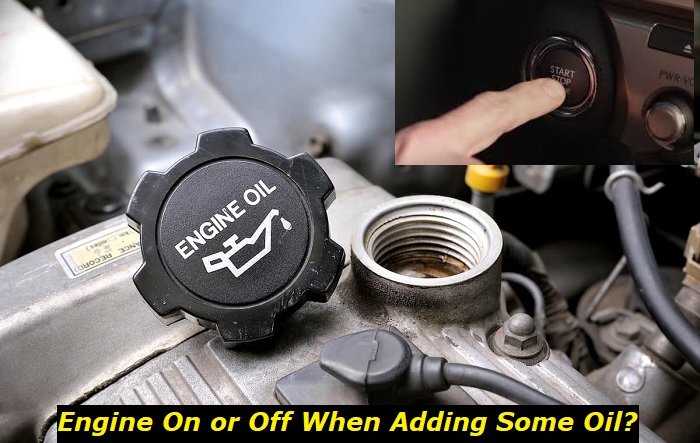Your car engine should be off when putting oil in it or when you're just checking the oil level. This is an issue that confuses many vehicle owners and may discourage them from performing DIY oil changes. I have elaborated more on it and other related topics in the subsequent sections.
Oil level problems highlights
- Level of urgency:medium
- Average mileage:not related to mileage
- Repair cost:$5 - $550
- DIY repair:yesbutmaybe complicated
- Commonreasons:overfilled oil, coolant leaking into oil, gas leaking into oil
- If ignored:fatal engine damage, catalytic converter damage
- How to solve:add oil or pump it outdependingon the nature of the problem

Why You Shouldn't Put Oil in a Car While It Is On
It's risky to work under your car's hood while the engine is on. For example, the danger posed by the working fans and belts. They can cause serious burns or cuts if you aren't careful enough.
Long hair or loose clothing parts can be caught in them and pulled, thus exposing you to great hazards. Let's not forget about the heat produced by the engine.
Why Is Engine Oil Important in a Car?
A car's engine has numerous metal parts that move continuously as the engine works. These metal components rub against one another and need constant lubrication.
Motor oil flows around the engine to provide lubrication, guarantee optimal operation, and reduce heating. It's only right that you change it regularly as an engine maintenance practice.
Changing the oil regularly or when needed helps you prevent bad engine performance, total engine failure, and a voided warranty. It also protects the engine's internal components from friction, oxidation, corrosion, and certain contaminants.
When To Do an Oil Change or Top-Up
An oil replacement is typically done between 5,000 to 10,000 miles depending on the recommendations of car manufacturers. Vehicle models made in recent years require longer oil swap intervals due to developments in motor oil and engine technologies. The change can also be performed in the following situations:
- When the oil is deemed old or dirty
- Low oil level
- Abnormal engine noises
- Engine light alerts
- Too much vehicle exhaust
- Irregular oil texture
- Ticking sounds on starting the car
- When the car is shaking while idling
- A leak or the oil can symbol flashing on your dash, necessitating an emergency refill
- Rough running of the vehicle
Things You Need for Oil Checks and Swaps
Some items should be readily available for an oil check or change to be done safely, neatly, and efficiently. You should be equipped with the following before doing either of the two or both:
1) Engine Oil
It's essential to ensure that the proper oil type is used for your car. Making use of different oil types can damage your engine or adversely affect your engine's performance.
You'd want to avoid the massive cost of replacing the entire engine. That's the result of irreparable damage that could have been avoided with a simple proactive oil replacement.
2) Small Towel
Getting a small, clean, and disposable towel for the job is an additional way to make the procedure neat. All the mess that comes with checking the oil or performing an oil change can be wiped off well with a standard quality thick towel.
3) Long-Neck Funnel
Utilize a funnel to prevent spills while pouring oil into your car. You'll ensure a neat process with this tool. The funnel should be compatible with the mouth of the oil tank.
4) Rubber Gloves
You don't have to touch the oil with your bare hands during checking or filling. Avoid greasy skin stains by wearing rubber gloves on both hands.
Other items that should be considered are new motor oil, a wrench (preferably adjustable), a new oil filter, new motor oil, a new oil plug, and an oil drain pan.
How To Check Your Car's Engine Oil Level
These five steps are what you need to examine the vehicle's oil levels regularly. Don't forget to have a clean towel, motor oil, and maybe rubber gloves before beginning.
Step 1: Create Safe Conditions for Checking
Users of older cars should check the oil when the engine is cool or after cooling the vehicle. The oil would have completely drained into the pan, allowing for an accurate reading.
Those using the latest models should drive for 10 minutes and let the car sit for 20-25 minutes to cool down a little. Your target is a warm engine, as this is the best temperature for checking the oil of such cars.
The oil would have drained into the pan fully in that time. You can play safe by waiting for the oil temperature to get back to normal.
Step 2: Park Your Car Properly and Conveniently
Don't park the vehicle on a slope or hill, as this can cause an inaccurate oil level reading. It should rather be on a flat surface that will give the best possible result.
Step 3: Locate the Engine Oil Dipstick
The dipstick should be found in the engine bay under the hood. It may be T-shaped or loop-shaped, with the handle usually labeled "engine oil" in yellow.
Step 4: Pull Out and Return the Dipstick
Use a clean, dry towel to wipe the dipstick clean and put it back in its place securely.
Step 5: Analyze the Oil Level
Remove the dipstick to examine the oil level. Do a top-up or refill if the position is below or at the "add" or "low" mark. You can decide not to add any oil if the level is above the mark (in the "full" section).
How To Carry Out an Oil Change
You can perform an oil change on your own with the DIY steps described in this section. It will help you to save some money instead of seeking the paid services of an auto mechanic.
Step 1: Get Underneath the Car Safely
Use an alligator-type jack to hold the vehicle up. Another method is to drive the car onto a garage ramp to allow access to its underside. Fix wheel blocks behind the rear tires to prevent them from rolling if the car is on a ramp.
Step 2: Find the Drain Plug
The plug is a big plug or nut that is positioned under the oil pan (big tank) at the engine's bottom.
Step 3: Drain the Oil Out
Place the oil drain pan under the drain plug. Unscrew the drain plug after that to let the oil pour into the drain pan. Your hands should be covered with gloves before you unscrew the plug. But be ready to move them out of the way after the plug is removed.
Step 4: Remove the Oil Filter
This will enable you to gain access to the oil filter compartment and clean it up. There should be no visible trace of oil from the filter compartment.
It's best to remove the oil filter before draining the oil if your filter insert is located at the engine top. But you can remove the filter after draining the oil if it is positioned at the engine bottom.
Step 5: Install a New Filter
This is necessary every time you change the filter. The O-rings need to be swapped out as well. Set the new filter in place and tighten the filter cap.
Step 6: Reconnect the Oil Drain Plug
You can do this with an adjustable wrench. Remove the oil drain pan too.
Step 7: Pour the New Oil
Utilize a funnel to make this easier. You'll find the oil cap at the engine top. Read the vehicle manual to know the required quantity of oil. Return the oil filler cap to its rightful place once you're done.
Step 8: Run the Engine
This should be done for 1 minute. You'll then put the engine off for at least 5 minutes for the oil to settle in the oil pan. Look for leaks around the filter as you wait. Check the oil level after and keep repeating step 8 until you get the desired measurement.
Call your local auto mechanic to examine the car in case where there is no change in oil level. Don't use your car in such a situation.
Step 9: Put Everything in Place Securely
Take out the funnel and return the oil cap and dipstick once you get the desired results. The last thing would be the satisfying closing of your hood.
Step 10: Record the Oil Replacement
Note the time of replacement, including the mileage shown on your car's odometer. The scheduling of your next routine oil change will be based on this information.
Conclusion
Both the over-filling and under-filling of the tank should be avoided. Don't aim for the highest-level mark in filling your tank. It's best to aim a little below it. Pouring excess oil can make the quantity in the oil pan too much, leading to increased engine pressure. Engine faults will develop as a result.
I advise that you take a thorough look at the vehicle owner's manual for any manufacturer specifications as regards oil checks and replacements. The information in this article should be adequate in addition to what you see in the manual.
About the authors
The CarAraC research team is composed of seasoned auto mechanics and automotive industry professionals, including individuals with advanced degrees and certifications in their field. Our team members boast prestigious credentials, reflecting their extensive knowledge and skills. These qualifications include: IMI: Institute of the Motor Industry, ASE-Certified Master Automobile Technicians; Coventry University, Graduate of MA in Automotive Journalism; Politecnico di Torino, Italy, MS Automotive Engineering; Ss. Cyril and Methodius University in Skopje, Mechanical University in Skopje; TOC Automotive College; DHA Suffa University, Department of Mechanical Engineering






Add comment